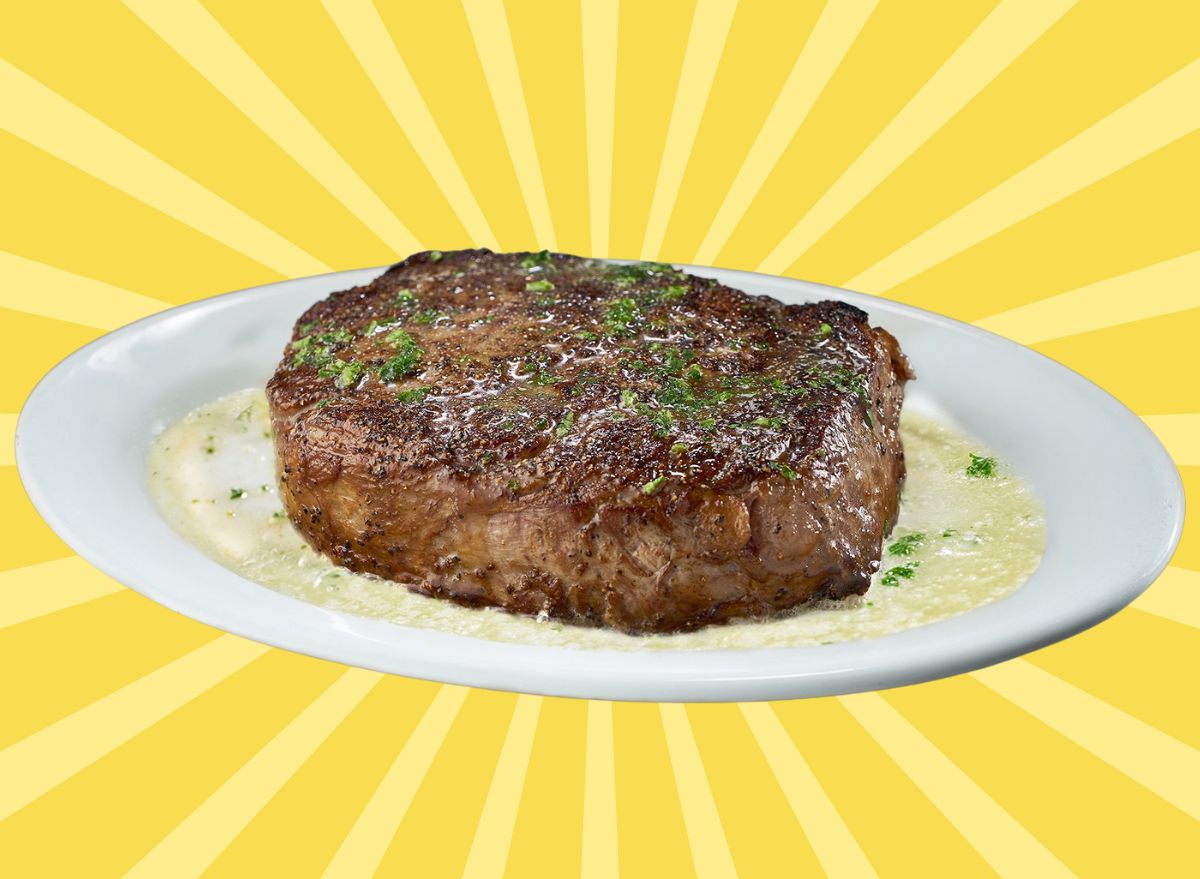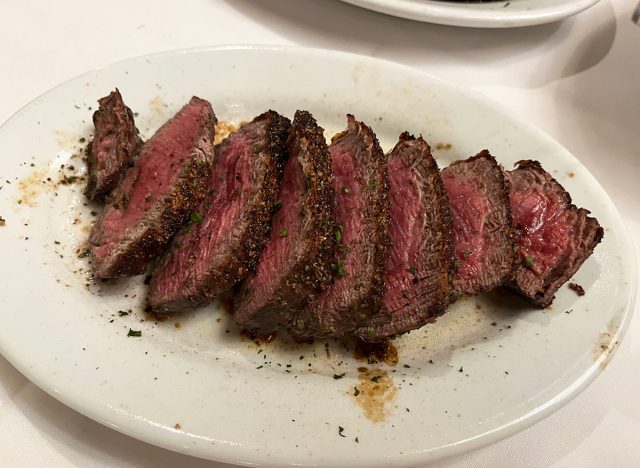I Tried 4 Popular Steaks at Ruth's Chris Steak House & One Was Exquisitely Tasty

If you've never dined at Ruth's Chris Steak House, you really should experience it at least once—if only for the sizzle. It's one of the signature touches at America's new favorite restaurant chain: fresh-broiled hunks of USDA Prime beef come out hissing and spitting on scorching-hot, bone-white plates, bubbling with melted butter.
The heated dishware is explained as a way of keeping the meat warm throughout your meal, but it's really as much about form as function. The presentation alone is a feast for your senses before you even take a bite.
The nation is flush with popular steakhouse chains, ranging from casual, value-oriented restaurants with broken peanut shells famously scattered across the floor to high-end, glamorously well-appointed dining rooms known for their big-ticket entrées and extravagant wine lists. Along this diverse spectrum, Ruth's Chris stands at a pivotal intersection, promising first-class meats with a relaxed dress code.
Founded nearly 60 years ago in New Orleans, this longstanding franchise with over 150 locations worldwide is showing signs of a major revival since joining the Olive Garden family, aka Darden Restaurants, in a blockbuster $715 million deal last summer. Darden pledged to make $10 million worth of immediate improvements to its newly acquired fine-dining brand and quickly initiated several changes in both the food and overall operation.
Those efforts already appear to be paying off. In a data-driven Technomic survey of U.S. consumers earlier this year, Ruth's Chris outperformed every other restaurant chain, earning especially high marks for its service, appearance, and ambiance.
Yet, as good-looking and friendly as it seems, Ruth's Chris is certainly not a cheap place to eat, which probably explains why the beloved chain scored noticeably lower in the same poll with regard to value. According to the restaurant's website, all the steaks are either USDA Prime, the highest-quality grade given to U.S.-raised beef, or "high cuts of Choice," the second-highest possible grade. Such top-notch sourcing naturally elevates the price tag.
The listed menu prices at my nearest Ruth's Chris location in Jersey City, N.J., range from $54 for an 8-ounce petite filet mignon to $149 for a 40-ounce tomahawk ribeye—and that's just for the beef. Sides will cost you extra.
With a nice steakhouse dinner coming at such a considerable cost, it's important to make the right call when deciding which entrée to order. That's why I recently taste-tested several of the most popular steaks at Ruth's Chris, so you'll know the best move when it's time to splurge.
While the menu includes a total of 10 different steak options, they're essentially all variations on one (or two) of three common cuts: filet, strip, and ribeye. The major differences between them are size and whether it's served bone-in or boneless.
For a proper sample, I selected four specific cuts in an attempt to cover all the major bases. Two of these items were highlighted in red on the restaurant's menu, signifying each as one of "Ruth's favorites," a reference to the restaurant's late founder, Ruth Fertel. (One would expect these to be among the best choices available.) I ordered each medium rare and served pre-sliced so my fellow red meat-loving companions and I could easily judge them all based on appearance and taste.
Here's how each of these four premium-priced steaks fared, ranked in descending order from my least favorite to the overall best.
T-Bone

Calories: 1,220
If you can't decide between a filet and a strip, then the T-bone is a good compromise. You basically get both cuts with the added bonus of a big, flavor-enhancing bone parked right in between. As good as that might sound, however, this best-of-both-worlds approach sometimes gets subpar results. Cooking a delicate filet and firmer strip at the same time can be tricky to get right. On several occasions at other steakhouses, I've ended up with a very uneven piece of meat. Either the filet side is too well done, or the strip side is too rare. Even so, I was curious to see whether Ruth's Chris could more deftly maneuver this beefy dilemma.
My nearest Ruth's Chris location currently offers two varieties of T-shaped steaks, including a 40-ounce porterhouse for two, priced at $123. I opted for the more modest 24-ounce T-bone for $68.
The look: Considerably sized but clearly overcooked. This hulking piece of meat was the thickest of the four at about an inch and three quarters, and the defining T-shaped bone stretched over seven inches long from top to bottom. The exterior was noticeably charred but inconsistently so. Right away, in its sliced state, you could tell the kitchen overshot the requested temperature by several degrees. Whether it stayed too long under the broiler or rested too long on its hot serving plate was unclear. The strip side showed only the faintest hint of pink while the filet side was 100% brown.
The taste: Well-seasoned but way too well-done. Whatever its faults, Ruth's Chris has its seasoning down to a science. Some steakhouse chains are way too heavy-handed with the spice shaker, while others seem to hardly give a sprinkle. At Ruth's, you get just the right amount of salt and pepper, before the meat is finished with chopped parsley and a stiff dose of butter. This ensures that your steak is at least somewhat flavorful, even when its woefully seared to cinder like this waste of otherwise good prime beef. Maybe I'm just unlucky with this particular cut, but at these prices, why take the risk?
Cowboy Ribeye

Calories: 1,690
I'm not much of gambler, but if I were, I'd put my money on the bone-in ribeye winning these taste-test contests nine times out of 10. In my experience, it usually does. The ribeye is a marvelously well-marbled cut and the bone-in version benefits from added minerals and marrow, combining for a truly flavor-packed piece of meat.
Some critics will tell you it's smarter to order a boneless cut because you're paying for the weight of the bone and you'll end up with more actual meat without it. Bone-in fans, meanwhile, are adamant about the attachment's almost-magical flavor-enhancing properties. As a guy who's consumed both boneless and bone-in ribeyes back-to-back in one sitting at the same restaurant, I can vouch for the difference in softness and lusciousness of the meat. That's why I'm Team Bone-In all the way.
My local Ruth's offers a range of ribeye options, including a boneless 16-ounce cut for $71, as well as a monstrous 40-ounce tomahawk chop for $149, but I went with the 26-ounce bone-in Cowboy Ribeye. At $81, it's the most expensive steak in this survey—and the biggest, too.
The look: Sprawling. Though only about an inch thick, the vast slab of meat nicely filled out its serving plate. The bright green flecks of parsley on top provided a vibrant contrast against the steak's dark char. Each slice showed a hot pink center with brown edges, a little more done than I like—but not overdone like the T-bone.
The taste: Lush and fatty. This tender, rich-flavored cut mostly lived up to my expectations with its salty crust and juicy interior. Thing is, there were two other steaks that my tasters and I found even more flavorful.
Filet

Calories: 500
The classic filet mignon tends to be one of the more affordable cuts at upscale steakhouse chains like Ruth's and its contemporaries, Morton's, Del Frisco's, and fellow Darden-owned sibling, the Capital Grille. At my local Ruth's, the 8-ounce petite filet is a relatively good deal at $54. You can also upgrade to a fancier, 16-ounce bone-in filet for $78. But my eyes were drawn to the standard 11-ounce filet, highlighted in red letters on the menu, denoting its status as one of "Ruth's favorites."
In the hands of a careless cook, this delicate cut can come off a little bland and boring, but in the right hands, it can be divine. The lone boneless cut in this survey, Ruth's filet cost me $62, and it did not disappoint.
The look: Stunning. Each fibrous slice beamed with juicy redness, verging on rare-looking, outlined by its crusty, charcoal-colored exterior. "The color is gorgeous!" my wife swooned. "As far as hot, beautifully prepared steak, this is pretty great."
The taste: Perfectly salted and peppery. Ruth's deft touch with seasoning really shined in this cut. Every bite was tender, moist, and flavorsome with the crusty edges adding some texture to an otherwise super-soft chew. As good as the filet was, though, one other steak really blew us all away.
Bone-In New York Strip

Calories: 1,010
Of all the tantalizing steaks listed on the Ruth's Chris menu, only two are emblazoned in red as "Ruth's favorites." The regular filet is one. The bone-in New York strip is the other. The strip also gets a special shout-out as "Ruth's favorite." Full stop. Once you try it, you'll understand why.
You can also order a smaller, boneless version of the same steak for the same price, but in this case, you should simply follow the clear guidance of the steakhouse matriarch. Described as "full-bodied," this 19-ounce USDA Prime specialty cut cost me $71.
The look: Impeccably charred outside and lusciously pink inside. The substantial bone stretched over eight inches along the backside, while the meat measured a full inch and a half thick.
The taste: Rich and exquisite. The expertly caramelized crust really stood out with this cut, attaining a saltiness and depth of flavor that none of the other steaks could match. "The filet was good—until I tried the strip," my friend said. "It's just so much more flavorful and rich and delicious." My wife added, "It tastes more expensive, which it probably is." She wasn't wrong about the cost, but the difference in price is marginal compared to the difference in taste.
This strip was simply a cut above the rest, a next-level delicacy that truly lives up to its "specialty" billing. If you only get one chance to dine at Ruth Chris, be sure to order the bone-in strip—and savor that signature sizzle.









